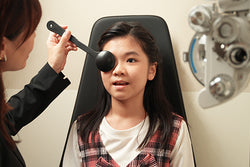
Photochromic lenses are lenses that are equipped with photochromic dyes that enable the lenses to activate and darken when they are exposed to the ultraviolet light (UV) from the Sun. The greater the intensity of UV rays, the darker the lenses become. Because UV rays penetrate clouds, photochromic lenses will darken on overcast days as well as sunny days.
In instances where UV light is absent such as indoors or at night, the lenses fade back to their original clear state. The darkening and fading processes are automatic, thus allowing seamless adaptation to changing light situations, providing the wearer with visual comfort even on a bright Sunny day.
Transitions® lenses are the #1 eyecare professional recommended photochromic lenses worldwide. Transitions® lenses block 100% of UVA and UVB rays and filter blue-violet light indoors and outdoors. With the newest Transitions® Signature GEN 8, the lenses are more responsive to varying light intensities – it darkens up to 30% faster, and the fade back time from dark to clear is up to 3 minutes faster than previous generations of Transitions.
As Transitions® are activated by UV rays, the lenses remain clear within the car, as the car windshields block out most UV light. However, to meet the diverse visual needs of consumers and with new cutting-edge technology, the invention of Transitions XTRActive® lenses allow the lenses to darken even within the car, as the special photochromic molecules within the lenses respond to both UV as well as visible light. Transitions XTRActive® lenses is recommended for those who spend long time behind the wheel or those who are extremely light-sensitive, as they are extra dark outdoors.
For those who spend a lot of time outdoors especially where glare is present such as water activities or on snow surfaces, Transitions XTRActive® Polarized lenses are ideal. These lenses polarize as they darken, providing maximum visual clarity and comfort even in bright, reflective conditions.
Book an appointment here or visit our store and speak to our Eyecare Pro to find out which Transitions® lenses best suit your visual needs.
https://www.transitions.com/en-us/why-transitions/the-technology/photochromic-tech/




